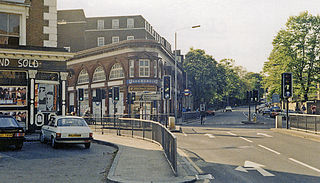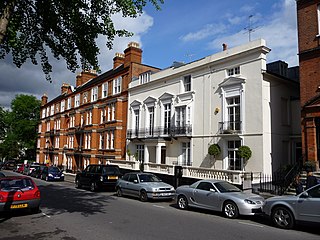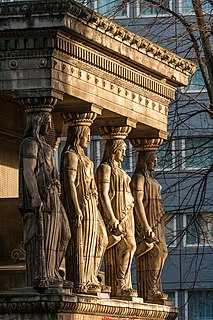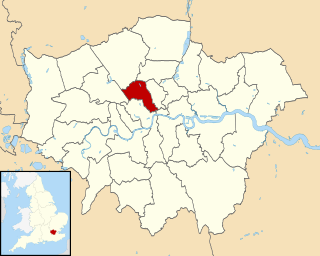
Chalk Farm is a small urban district of north London, lying immediately north of Camden Town, in the London Borough of Camden.

Clerkenwell is an area of central London, England.

Hampstead is an area in London, which lies 4 miles (6.4 km) northwest of Charing Cross, and extends from the A5 road to Hampstead Heath, a large, hilly expanse of parkland. The area forms the northwest part of the London Borough of Camden, a borough in Inner London which for the purposes of the London Plan is designated as part of Central London.

St Pancras is a district in north London. It was originally a medieval ancient parish and subsequently became a metropolitan borough. The metropolitan borough then merged with neighbouring boroughs and the area it covered now forms around half of the modern London Borough of Camden. The area of the parish and borough includes the sub-districts of Camden Town, Kentish Town, Gospel Oak, Somers Town, King's Cross, Chalk Farm, Dartmouth Park, the core area of Fitzrovia and a part of Highgate.

Kings Cross is a district on either side of Euston Road, in north London, England, 1.5 miles (2.4 km) north of Charing Cross. It is bordered by Barnsbury to the north, Clerkenwell and Islington to the east, Holborn to the south and Euston to the west. It is served by two major rail termini, St Pancras and King's Cross. King's Cross station is the terminus of one of the major rail routes between London and the North.
Somers Town is an inner-city district in North West London. It has been strongly influenced by the three mainline north London railway termini: Euston (1838), St Pancras (1868) and King's Cross (1852), together with the Midland Railway Somers Town Goods Depot (1887) next to St Pancras, where the British Library now stands.

Farringdon is a London Underground and connected main line National Rail station in Clerkenwell, central London. The station is in the London Borough of Islington, just outside the boundary of the City of London. Opened in 1863 as the terminus of the Metropolitan Railway, the world's first underground passenger railway, Farringdon is one of the oldest surviving underground railway stations in the world.

Farringdon Road is a road in Clerkenwell, London.

The Peabody Trust was founded in 1862 as the Peabody Donation Fund and now brands itself simply as Peabody. It is one of London's oldest and largest housing associations with around 55,000 properties across London and the South East. It is also a community benefit society and urban regeneration agency, a developer with a focus on regeneration, and a provider of an extensive range of community programmes.

The London Borough of Camden is a London borough in Inner London. Camden Town Hall, on Euston Road, lies 1.4 mi (2.3 km) north of Charing Cross. The borough was established on 1 April 1965 from the area of the former boroughs of Hampstead, Holborn, and St Pancras—which together, prior to that date, had comprised part of the historic County of London.

Camden London Borough Council is the local authority for the London Borough of Camden in Greater London, England. It is a London borough council, one of 32 in the United Kingdom capital of London. Camden is divided into 18 wards, each electing three councillors.
Model dwellings companies (MDCs) were a group of private companies in Victorian Britain that sought to improve the housing conditions of the working classes by building new homes for them, at the same time receiving a competitive rate of return on any investment. The principle of philanthropic intention with capitalist return was given the label "five per cent philanthropy".
The Labourer's Friend Society was a society founded by Lord Shaftesbury in the United Kingdom in 1830 for the improvement of working class conditions. This included the promotion of allotment of land to labourers for "cottage husbandry" that later became the allotment movement, which the Society campaigned for after the Swing riots of 1830 as "the most plausible remedy for the social problems of the countryside". It published the Labourer's Friend Magazine, and in 1844 changed its title to the Society for Improving the Condition of the Labouring Classes, becoming the first Model Dwellings Company in 1844.
The Improved Industrial Dwellings Company (IIDC) was a Victorian Model dwellings company founded in 1863 by the printer, philanthropist and later Lord Mayor of London Sir Sydney Waterlow. The company operated predominantly in Central London as a provider of block dwellings for the working classes, employing a strict selection and discipline regime amongst its tenants to ensure a healthy return on investment. Starting with a capital of £50,000, the IIDC became one of the largest and most successful of the model dwellings companies, housing at its height around 30,000 individuals.
The East End Dwellings Company was a Victorian philanthropic model dwellings company, operating in the East End of London in the latter part of the nineteenth century. The company was founded in principle in 1882 by, among others, Samuel Augustus Barnett, vicar of St Jude's Church, Whitechapel; it was finally incorporated in 1884.
The Industrial Dwellings Society (1885) Ltd. (IDS) was formed in London during the Victorian era as a philanthropic model dwellings company, known at the time as the Four Per Cent Industrial Dwellings Company. In 1952 the organisation took its present name and form and is today commonly known as simply IDS.

Prince Albert's Model Cottage was the name given to a model dwelling designed in the mid-19th century to offer an alternative form of accommodation for poor families in England. It was supported by Prince Albert, husband of Queen Victoria.
Thomas Field Gibson FGS was a Unitarian silk manufacturer and philanthropist. He supported several novel initiatives to enhance British manufacturing quality and international trade while improving life for working people during the industrial revolution – particularly in Spitalfields where his business was centred. He also made important contributions to geology.

Camley Street is a street in the London Borough of Camden in London, England. It lies in St Pancras and King's Cross: stretching over a kilometre from St Pancras railway station in the south, over the Regent's Canal, and to Agar Grove in the north.











